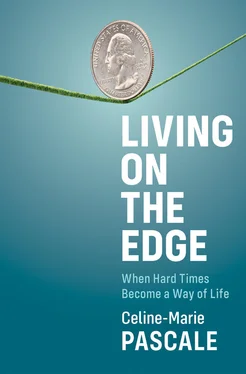Rose is smart, hardworking, and broke. She describes her current level of work as unsustainable but even so she cannot afford the basics of being able to live alone, pay for car repairs, and cover medical bills. Rose worries about the future. “I don’t need food stamps, but there have been times in my life where I’ve considered getting food stamps, but, as of right now, I don’t need them.” Rose pauses for a moment and takes a breath, “but if I were to ever have a child or have anybody else depend on me, that would have to be a possibility.” It isn’t an easy thought. It is a desperate one. Without access to reproductive health care – including abortion – an unplanned pregnancy would end her ability to work and force her and her child more deeply into poverty. As we will see in later chapters, for low-wage workers, marriage does not always offer a way out of poverty.
The experiences of Michael and Rose in Southeast Ohio are familiar to others living in the area. Like millions of others, they are caught in economic quicksand. For low-wage workers, it is impossible to work your way out of poverty. Without paid sick time, just a bad case of the flu will throw their ability to keep a roof over their head into question. More than 1,200 miles away, at the Standing Rock Sioux Reservation, things are both quite different and remarkably similar.
Standing Rock Sioux Reservation
When I land in Rapid City, South Dakota, on September 12, 2017, more than forty-eight wildfires are burning in Montana; they would go on to consume more than 1,295,000 acres before being contained a few weeks later. 8Hundreds of miles from Montana, the fires were turning the South Dakota sky to ash. On my way to the Standing Rock Sioux Reservation in the northeast, I pass mile after mile of sunflowers – most of them damaged or destroyed by drought. For most of the drive, the car radio picks up only two stations: one playing country music and another broadcasting a Christian preacher. As I pass the enclave of Timber Lake on the Cheyenne River Reservation, the radio picks up Standing Rock’s station, which plays a mix of community news, pop, rock, and traditional tribal music. And for the first time in hundreds of miles, my phone picks up a Wi-Fi signal, also coming from Standing Rock.
Although American Indian tribes are sovereign nations, the status of Native peoples in the US remains both unclear and precarious because a great deal of US policy rests on foundations of genocide, treaty abrogation, racism, and repression of tribal histories. 9The US reservation system was initially established along the lines of concentration camps under a colonial occupation. Today, the far-reaching occupation includes geographical displacement, ongoing disregard for Native rights, appropriation of tribal land and resources, destruction of natural resources, contamination of Native land and water, prohibitions against religious practices, as well as geographic and political isolation.
The entire Midwest region was shaped by war and broken treaties that continually forced Plains Nations into smaller, more desolate areas, often separating cultures from their most sacred sites. 10The Great Sioux Nation is composed of Seven Council Fires: Oglala, Brule, Sans Arcs, Blackfeet, Minnekonjou, Two Kettle, and Hunkpapa. 11Today, members of the Great Sioux Nation live on five reservations across the Midwest: Pine Ridge, Rosebud, Lower Brule, Cheyenne River, and Standing Rock.
The Standing Rock Sioux Reservation was established by the federal government in 1889. Agricultural land that was owned by whites at the time was grandfathered into the reservation. In 2018, there were 454 farms on Standing Rock, only ninety-one of which were Native owned. 12Today, the Standing Rock Reservation is home to Dakota and Lakota nations and spans 3,572 square miles across Corson County, South Dakota and Sioux County, North Dakota. 13
The US government has consistently intervened in the lives of Native citizens in ways that are unprecedented elsewhere in the country. For example, in 1823, Supreme Court Justice John Marshall articulated a broad interpretation of existing law that unilaterally removed from Native people the right to sell their land. Tribal governments have no rights regarding the occupation of their land, unless the federal government agrees to those rights. 14And, tribal health, law, and government remain contingent on federal bureaucracies and laws imposed upon them. Native people were not granted full citizenship, including the right to vote, until the Snyder Act was passed in 1924 – four years after the 19th Amendment granted women the right to vote and fifty-four years after the 15th Amendment granted Black men the right to vote.
Even today, the federal government retains the right to decide who is and who is not Native American and it continues to issue identity cards to Native people that certify the degree of “Indian Blood” they have. 15Native people must prove the legitimacy of their identity through a federally set blood quantum – and many do not qualify. As a result of this racist imposition, Native people have been denied the rights of tribal membership, even when it is clear that they belong to the culture and community. This shocking practice calls to mind the race-identity cards South Africans were required to carry during apartheid.
When I arrive in Standing Rock, the reservation is home to 8,616 people with a nearly equal number of tribal members living off the reservation. The population at Standing Rock is young; 46% of residents are below the age of twenty-four. 16While the national unemployment rate hovers at 3.1%, at Standing Rock that number is closer to 79%. 17And the poverty rate is 43.2%, nearly triple the national average. The scarcity of jobs and economic opportunities creates high unemployment and overcrowded housing. Most low-income residents live with family members, which can lead to overcrowded and unsafe conditions. 18
On reservations, tribal and federal governments are the largest employers. At Standing Rock, the tribe owns and operates two casinos that employ almost 600 people, and several smaller businesses including restaurants, campgrounds, a convenience store, and a marina. 19This level of development is impressive, considering that all Indian lands are held in trust and managed by the federal government. Nearly every aspect of economic development on Indian land is controlled by federal agencies. For example, companies must go through four federal agencies and forty-nine steps to get a permit that would take only four steps off of the reservation. 20The occupation of Native peoples has been bureaucratized to devastating effect. The so-called guardian–ward relationship between the federal and tribal governments is not a trustee–beneficiary relationship, as is often claimed. Tribal governments are reduced to domestic dependent nation status and forced to rely on federal government agencies that are underfunded and difficult to access. 21The federal management of Native resources and economies has created levels of poverty on reservations on a par with undeveloped nations.
Standing Rock is a sprawling community organized by Districts, eight in all, each with their own governance structure and many with substantial populations. 22Many people at Standing Rock do not live in formally organized towns – even the two casinos/hotels are not part of towns. There are just three towns on the reservation, all about thirty miles apart: McLaughlin in South Dakota (population 679), and two towns in North Dakota: Fort Yates (population 200) and Cannon Ball (population 875). 23
Fort Yates is home to Sitting Bull College and to the Standing Rock Tribal government. The beautiful college campus stands as a promise to the future in a community that prizes its children. The tribal government works hard to support youth, and just down the road from the college is a modern public school campus that contains buildings for elementary, junior high and high schools. Fort Yates itself is a crossroads with a grocery store, gas station, post office and bank. Just north from Fort Yates is the town of Cannon Ball. Half of the families in Cannon Ball have incomes below the federal poverty line; and, nearly half of the residents are children under eighteen. 24
Читать дальше












